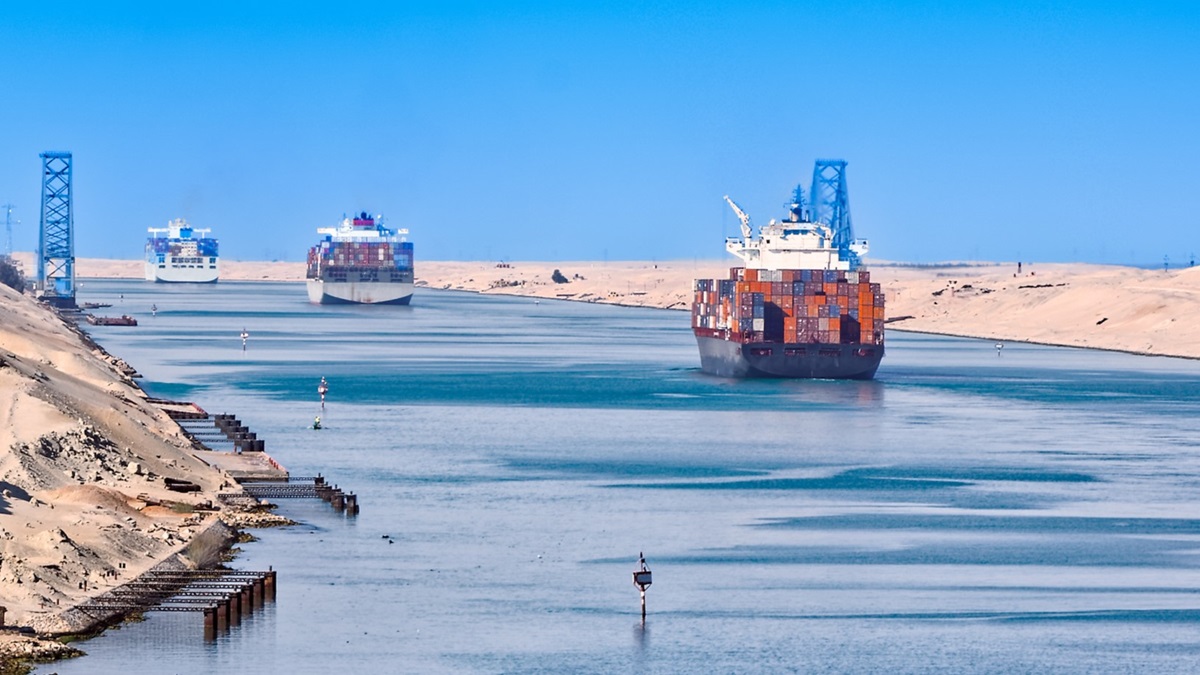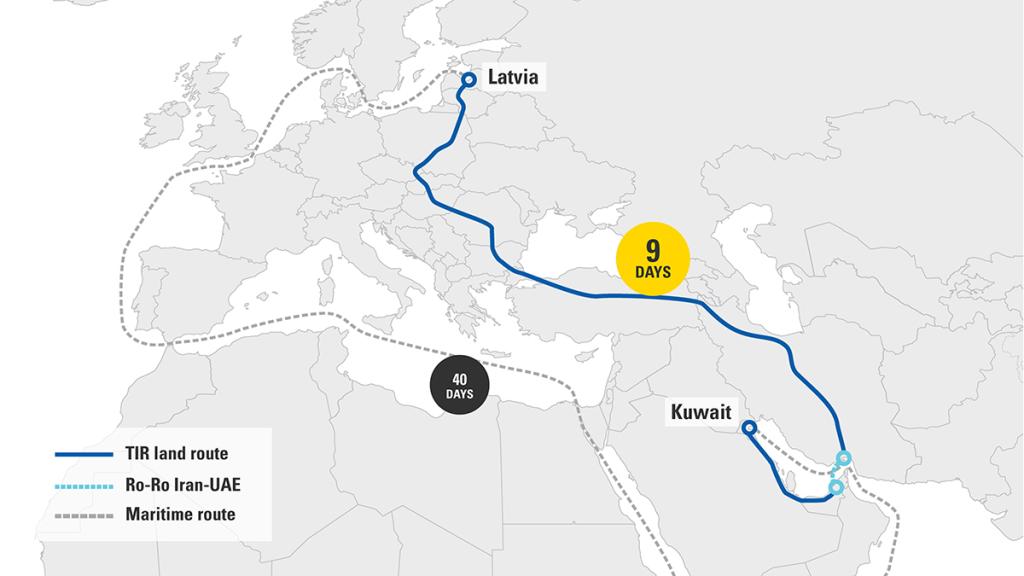Written by Tatiana Rey-Bellet, Director TIR and Transit at IRU, Article No. 115, [UNCTAD Transport and Trade Facilitation Newsletter N°101 - First Quarter 2024]

© Shutterstock/Igor Grochev | Container ships sail through the Suez Canal.
Recent crises have shifted global trade routes. Trade facilitation tools and digitalisation are needed more than ever to facilitate the flow of goods.
Geopolitical developments over the past few years have redefined trade routes, with freight flows through traditional routes, such as the northern Eurasian corridors, having fallen significantly since the start of the war in Ukraine.
Now more recently, east-west trade has been hit by the Red Sea crisis, requiring transport companies to once again look for alternative routes.
New routes have emerged in recent years to facilitate east-west trade. But they need our support.
The Middle and Southern Corridors
Connecting China and Central Asia via the Caspian Sea or Iran to Türkiye and Europe, both the Middle Corridor and Southern Corridor have become critical trade routes, reshaping the global dynamics of transport and trade. They allow for door-to-door road transport and the efficient combination of different modes.
In 2022, transit via the Middle Corridor saw record growth in transit volumes, increasing by 150% compared to 2021. In just one month, from December 2022 to January 2023, the container turnover in the Caspian Basin underwent a 5.5-fold increase. From January to August 2023, freight volumes from China to Europe along the Middle Corridor increased by 84% compared to the same period in 2022, surpassing 1.6 million tonnes.
The Southern Corridor is similarly well placed to facilitate the flow of goods and east-west trade. On average, transport operations by Turkish operators from Türkiye to Kyrgyzstan, Tajikistan, Turkmenistan and Uzbekistan increased by 44% from 2020 to 2023. In the case of foreign operators, it rose by 86%.
Transport from Lianyungang, China, to Türkiye or EU countries via these corridors takes between 13 and 23 days. In contrast, the maritime route via the Suez Canal takes between 35 and 45 days.
Red Sea Crisis
The Red Sea crisis has now further accentuated global trade and transport challenges. As widely covered in the media, cargo ships are being rerouted around the southern tip of Africa to avoid the Red Sea.
Other companies are opting for more direct road routes. Using the UN TIR system, transport companies are rerouting their shipments via countries in the Gulf Cooperation Council (GCC) region, bypassing the blocked maritime leg by switching to trucks to go through the GCC region and the northern part of the Red Sea. The seaports of Sohar and Salalah (Oman) and Jeddah and Dammam (Saudi Arabia) have acted as the main ports of arrival where goods are then transhipped and transported via trucks across the region before continuing their journeys by sea.
But there are many other routes available to transport companies. Just last year, the Milton Group transported goods from Europe to the Middle East with TIR – crossing 13 countries – in just nine days, rather than taking 40 days by sea.

The goods departed from Latvia and transited Lithuania, Poland, the Czech Republic, Slovakia, Hungary, Romania, Bulgaria, Türkiye, Iran via the Bandar Abbas port and then to the United Arab Emirates using a Ro-Ro vessel and finally the Kingdom of Saudi Arabia, before arriving at their destination in Kuwait.
Across Asia, new TIR routes have opened in recent years. Since 2021, IRU and its partners have opened several corridors under TIR, including Islamabad-Tehran-Istanbul, Pakistan-Afghanistan-Uzbekistan-Kazakhstan, and China-Pakistan-Afghanistan. All three cut transport times by up to 80%, on average, compared to traditional routes.
Alternative routes and intermodality are necessary to ensure that regional and global trade routes can maintain their efficiency amid ongoing crises and geopolitical shocks.
Solutions
Investments in both hard infrastructure and soft procedures, services and tools are needed to keep up with increasing traffic at congested border crossings. But to maximise the potential of the Middle Corridor and Southern Corridor and build resilience, our strategic focus must shift towards soft trade and transit solutions.
Tried-and-tested tools, such as the TIR system, can significantly streamline trade flows and unblock congested border crossings. Harmonised instruments, including TIR, can ensure the security and transparency of transit movements, handle low-risk cargo faster, and reduce business costs.
Risk-based facilitation allows customs authorities to separate traffic flows and handle low-risk cargo faster. Central Asian countries, which are at the heart of east-west connectivity, are establishing dedicated TIR lanes for secure transport for which customs receive advance information for risk management via the TIR-EPD system.
With the record growth of trade volumes along the new corridors, it is becoming increasingly urgent to digitalise international transit to further improve trade security and efficiency.
Many TIR processes have already been successfully digitalised, bringing substantial benefits to the public and private sectors, and enhancing transit security and facilitation.
All Roads Lead to eTIR
Further to all the steps taken to digitalise TIR processes, the ultimate goal is a widespread implementation of eTIR in the coming years.
All necessary TIR digitalisation business-to-business and business-to-customs exchanges have been implemented, TIR countries now need to complete the last remaining piece of connectivity: interconnection with the eTIR international system hosted by the United Nations Economic Commission for Europe (UNECE)
eTIR will not only further boost TIR’s benefits by eliminating time-consuming paper-based processes. It will also make it much easier to bring TIR benefits to the service of intermodal transport, opening new opportunities for the efficient combination of different transport modes.
IRU and UNECE are working together to expedite the implementation of eTIR, which should be complemented by e-CMR, e-Visas and e-Permits. They all offer significant benefits and the ability to optimise transport operations.
For efficient digitalisation, it is important to avoid the duplication of data and the mechanisms through which the data is shared among the different authorities and entities representing various modes of transport. The transition to digital documents is an opportunity to optimise and minimise the exchange of data for everyone.
Global trade routes have been rocked by significant crises in recent years. The emerging new routes should be quickly backed by harmonised development tools and digitalisation to avoid any further setbacks to global trade.



